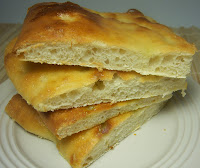Monday, January 31, 2011
Ciabatta Bread
Have you ever noticed how many of your memories are tied to a specific smell? For me it seems like the majority of my most vivid memories are tied to some kind of smell, usually from something great being cooked in the kitchen. Maybe that is one of the reasons I love to cook so much. Each time I do, I am usually reminded of some experience of cooking or spending time with friends and family. Homemade bread is certainly no exception and I believe that anyone that makes their own bread will agree that there is no better smell than walking in to your home after baking a fresh batch of bread.
This Ciabatta bread is a recipe that I have been eyeing for years in my Williams-Sonoma cookbook and just never got around to making. It does take some time, especially if you have to make your own sourdough starter, but the deep complex flavors are certainly worth the wait, and if you end up making the starter, there are always a number of other sourdough recipes you can use it for as well.
If you haven't had Ciabatta before, it is a thin bread that gets it's texture from dimpling the bread with your fingers as it rises. The result is a thin crusty bread that has light airy holes through out the top. It is fantastic cut or torn into strips and dipped into olive oil and fresh or dried garlic chunks.
Ciabatta
adapted from Williams-Sonoma Essentials of Baking
Ingredients
For the sponge:
1 teaspoon active dry yeast
1/2 cup whole milk, heated to warm (105-115 degrees)
1 1/4 cups cool water
1 cup sourdough starter (use one of your own or see recipe below)
2 cups bread flour
For the dough:
2 cups bread flour
1 tablespoon sea salt
1 tablespoon olive oil
1/4 cup corn meal
To make the sponge, in a large bowl, dissolve the yeast in the warm milk and let stand until foamy, about 5 minutes. Using a wooden spoon, stir in the water, sourdough starter, and bread flour. Cover the bowl with plastic wrap and let stand overnight at room temperature.
Transfer the sponge to the bowl of a stand mixer. Add the bread flour, salt and oil. Place the bowl on the mixer, attach the dough hook, and knead on low speed until soft and springy, 5-7 minutes. Periodically stop the mixer and scrape down the sides of the bowl and dough hook with a plastic pastry scraper. Remove the bowl from the mixer and scrape down the dough.
Cover the bowl with plastic wrap and let the dough rise for 3 hours at room temperature or overnight in the refrigerator. It should double in bulk.
If the dough has been refrigerated, shape it while it while it is cold. If it has been at room temperature, do not be daunted by how loose and wet it is. Sprinkle 2 pizza stones with a generous dusting of cornmeal. Generously flour the work surface with 1/2 cup of the all purpose flour. Using the pastry scraper, scrape the dough out of the bowl onto the floured surface. Cut hte dough in half with a sharp knife or a bench scraper.
Sprinkle more all purpose flour on top while you gently shape each piece with your hands into a long, flat rectangle about 6 by 16 inches. Carefully pick up the flat loaves and place 1 loaf in the center of each pan.
Dimple the loaves all over with your finger tips. Cover the loaves loosely with a kitchen towel and leave them to rise in a warm, draft-free spot until soft and puffy, 1-2 hours.
Position the oven racks in the middle and lower third of the oven, and preheat to 450 degrees.
Mist the loaves generously with water and immediately put the pans into the oven. Bake the breads until they are brown and sound hollow when tapped on the bottom, 20-25 minutes, switching the pans halfway through baking.
Transfer to wire racks and let cool completely before slicing or pulling apart.
Sourdough Starter
2 cups unbleached all-purpose flour
2 cups whole milk
In a glass or ceramic bowl, combine the flour and milk and stir with a wooden spoon until well mixed. Cover the bowl with plastic wrap and let stand at a cool room temperature for 3 to 4 days, stirring the mixture once a day. If it bubbles and has a nice sour smell, you have attracted airborne yeasts and friendly bacteria, which give sourdough its characteristic flavor. If the starter turns moldy or pink or starts to smell bad, throw it away and start again.
Subscribe to:
Post Comments (Atom)






Hey, nice site you have here! Keep up the excellent work!
ReplyDeleteCoolroom
Do you eat it? I would like to do this.A good article and very interesting.
ReplyDeleteสูตรบาคาร่า